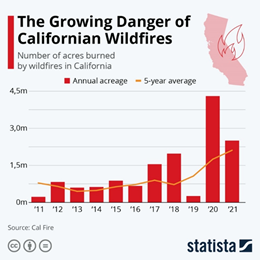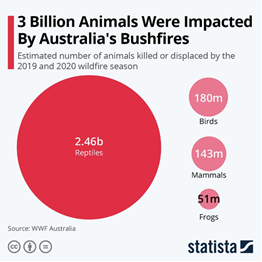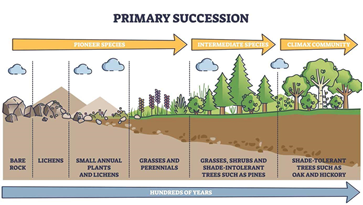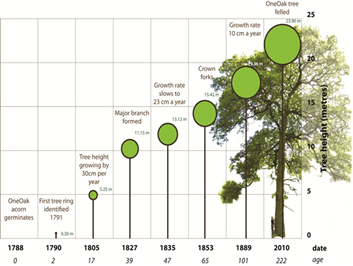1. Introduction
Wildfires have emerged as a global ecological crisis, causing extensive damage to ecosystems, loss of biodiversity, and disruption of natural processes. These uncontrolled blazes not only destroy vast stretches of forests but also have long-lasting impacts on the environment, wildlife, and human health. In regions like California, where wildfires have become increasingly frequent and intense, the devastation is particularly evident. As shown in Figure 1, Between 2015 and 2021, approximately 10.1 million acres of land were consumed by wildfires in California, leading to a significant reduction in biodiversity and threatening iconic tree species such as the Giant Sequoia. The aftermath of these fires is further complicated by the slow natural process of secondary succession, which can take years or even decades to replenish the ecosystem.

Figure 1. The growing danger of Californian wildfires [1].
The challenges posed by wildfires extend beyond immediate destruction. The loss of vegetation and soil structure leads to water contamination, soil erosion, and the introduction of harmful chemicals into the ecosystem. Invasive species often take advantage of the altered habitat, further hindering the recovery of native flora and fauna. Additionally, the migration of wildlife into human-populated areas can lead to unexpected and often dangerous interactions. Climate change, with its associated rise in temperatures and altered precipitation patterns, exacerbates these problems by creating conditions conducive to the spread of wildfires [2].
This paper analyzes the impacts of wildfires, with a focus on the state of California, and explores innovative strategies to accelerate the natural process of secondary succession. By understanding the complex interplay between wildfires, ecosystems, and human activities, we can develop targeted solutions to mitigate the damage and promote faster recovery. The insights and strategies presented in this paper offer a roadmap for policymakers, researchers, and communities to work collaboratively toward creating resilient ecosystems capable of withstanding and recovering from the devastating effects of wildfires.
2. The Devastating Impacts of Wildfires
2.1. Loss of Habitats and Biodiversity
A typical example of the wildfire’s impact on habitats and biodiversity is the California wildfires. The frequency and intensity of wildfires in California have reached alarming levels. Between 2015 and 2021, approximately 10.1 million acres of land were burned, leading to a significant reduction in biodiversity. This loss of habitats has had a profound impact on the ecological balance of the region, threatening both plant and animal species [3]. Further, among the most affected are certain tree species that are particularly vulnerable to wildfires. The iconic and ecologically important Giant Sequoia (Sequoiadendron giganteum) has faced considerable threats, with an estimated 10% of the world's mature Giant Sequoias killed in the 2020 Castle Fire alone. This loss not only affects the aesthetic value of California's forests but also disrupts the ecological functions these trees perform. The situation is further exacerbated by climate change. Prolonged droughts, rising temperatures, and changing precipitation patterns have created conditions conducive to fire spread and tree mortality. A study conducted by the University of California, Berkeley, found that since the early 1980s, climate change has doubled the area burned by wildfires in the state, amplifying the loss of habitats and biodiversity [3].
2.2. Water Contamination and Ecological Imbalance
The aftermath of wildfires extends to water contamination. Water treatment facilities in California were inundated by the deposition of sediment, dissolved organic compounds, and chemicals that were discharged due to a fire event. The inability to effectively treat this contaminated water poses serious health risks to both humans and aquatic life. The destruction of trees, vegetation, and stable soil structure leads to soil erosion and increased water runoff. Without natural barriers, further contamination of water sources could happen. The situation is compounded by chemical contamination. Dissolved carbon dioxide, when mixed with chlorine used to treat water, creates carcinogens, making the water harmful to humans. Many chemicals toxic to fish also enter the water, doubling lake nitrogen concentration and quadrupling phosphorus concentration. These increases may lead to algal blooms, resulting in extreme daily fluctuations in oxygen and stressing aquatic organisms.
2.3. Habitat alternation and wildlife migration
Wildfires also lead to habitat alteration. The burns create new open areas where dense forests used to be, quickly colonized by grasses, shrubs, and invasive species. This alteration adversely impacted the landscape, hindering the recovery of native species. The displacement of wildlife is another concerning consequence of wildfires. Animals, in an attempt to avoid flames and search for new habitat, wander into densely human-populated areas, leading to unexpected and often dangerous interactions. The scale of wildlife casualties is staggering. As shown in Figure 2, over 1 billion animals were killed in Australia's late 2019 fires, including various species like foxes, rabbits, deer, frogs, and more [4]. This loss further emphasizes the global nature of the wildfire crisis and the urgent need for comprehensive solutions.

Figure 2. Estimation of the status of the impacted wildlife in Australia [5].
3. Secondary Succession in Coastal Forest
Secondary succession is a vital ecological process that follows a major disturbance, such as a wildfire, in an ecosystem. Unlike primary succession (Figure 3), which occurs on lifeless terrain, secondary succession begins in areas where the existing community has been disrupted, but soil and some organisms remain. The process of secondary succession in coastal forests is a complex and gradual transformation that leads to the restoration of the ecosystem over time. It is initiated by the presence of intact soil, spores, seeds, and roots, allowing plants and animals to recolonize specific habitats after the intense disturbance of a wildfire event. Although the fire significantly alters large areas of land, it does not render it completely lifeless. The soil retains nutrients that onset the process of secondary succession, and the buried seeds deep within the soil begin to sprout shortly after the disturbance's effects. This process can be broadly categorized into three main stages: the Regrowth Stage, the Second-Growth Forest, and the Old-Growth Forest. Each stage represents a unique phase in the recovery of the forest, reflecting changes in vegetation, wildlife, and overall ecosystem function. The following sections will delve into the details of these stages, illustrating the remarkable ability of nature to heal and renew itself after the devastation caused by wildfires.

Figure 3. Scheme diagram of the process of primary succession [6].
4. Solutions to Speed up Succession
4.1. Mulching
One of the immediate responses to wildfires is the application of mulching. This technique is performed to prevent extreme soil erosion and reduce overland flow, which can be detrimental to the recovery of the ecosystem. Mulch, often made of slow-decaying tree bark fiber, is spread over the affected area to create a protective layer. This layer not only shields the soil from the impact of raindrops but also reduces runoff by increasing surface water storage and infiltration. According to CalRecycle, a California organization dealing with wildfire damage management, composts and mulching play a vital role in restoring soils by improving their physical, chemical, and biological properties [7]. They bind and absorb contaminants, including heavy metals and fuels, making them an ideal treatment for soil remediation. The mulch amendments help with fire damage, establish vegetation, moderate soil temperatures, suppress weeds, and release healthy nutrients, thereby accelerating the process of secondary succession.
4.2. Controlling Invasive Species
The aftermath of a wildfire often creates an opportunity for invasive plants like cheatgrass to dominate the landscape. These invasive species can interrupt, delay, or even prevent the process of succession by outcompeting native vegetation. Firefighters may inadvertently spread invasive species while responding to wildfires, introducing seeds or aquatic invasive species to new locations. Geo-spatial mapping and technology tools like CalWeedMapper are employed to develop spatially-zoned wildland fire and invasive plant management strategies. These tools provide specific information on the distribution of invasive plants and recommend management actions. Prevention measures, such as boot brushing stations to remove seeds and public education about the dangers of invasive species, are also essential in controlling their spread [8]. Collaboration between countries and constant updating of databases is vital for effective monitoring and management.
4.3. Artificial Structures
Artificial structures play a significant role in speeding up the process of secondary succession (Figure 4). Seed banks and nurseries act as custodians of biodiversity, preserving a diverse collection of seeds from various plant species. They identify the most suitable seeds for the specific post-fire environment, ensuring the right species are reintroduced. Biodegradable erosion control matting provides a protective layer that retains moisture and shields seeds from harsh weather conditions, promoting growth. Artificial wildlife habitats, such as dens, hollows, nests, and reefs, are created to substitute or supplement natural habitats destroyed by fire. Terracing and swales are implemented to reduce water runoff, facilitate rainwater infiltration, and support vegetation growth, fostering a more sustainable ecosystem.

Figure 4. A showcase of the application of artificial matting in speeding up the process of secondary succession [9].
4.4. Planting and Seeding
Planting and seeding are fundamental in restoring the ecosystem after a wildfire. Pioneer species like Fireweed, known for fixing nitrogen into the soil, and intermediate species like Birch trees, which grow rapidly, are used for this purpose (Figure 5). These species are carefully selected to match the specific needs of the affected area, considering factors like soil type, climate, and native vegetation. Government support and commitment are crucial for implementing these solutions, as they often require coordinated efforts and substantial resources. By investing in planting and seeding, governments can actively contribute to reducing the impact of wildfires and speeding up the natural process of secondary succession. The use of native species that are adapted to local conditions ensures that the restored ecosystem is resilient and sustainable, paving the way for a healthy and thriving environment.

Figure 5. The growing speed the Oak trees [10].
5. Conclusion
Wildfires pose a significant threat to ecosystems, causing loss of habitats, biodiversity reduction, water contamination, ecological imbalance, and alteration of wildlife habitats. The paper has thoroughly explored these severe impacts, using California as a prime example to illustrate the devastation caused by wildfires. The vulnerability of specific tree species, the role of climate change in exacerbating wildfires, and the complex challenges in water treatment and wildlife migration have been examined in detail. In response to these challenges, the paper has presented various strategies to accelerate the natural process of secondary succession. These solutions range from immediate interventions like mulching to long-term strategies such as controlling invasive species, utilizing artificial structures, and planting and seeding. The solutions are practical, multifaceted, and can be implemented with proper planning, collaboration, and commitment.
The findings of this paper underscore the urgent need for further research and collaboration among governments, researchers, communities, and other stakeholders. While the strategies presented are promising, they require continuous refinement, adaptation, and innovation to ensure their successful implementation across diverse ecosystems. The goal is not merely to recover what has been lost but to create resilient ecosystems that can recover from wildfires more quickly, sustainably, and in harmony with the native flora and fauna. Investments in technology, public education, international cooperation, and proactive land management are essential to achieving this goal. The lessons learned from the wildfires and the strategies to speed up secondary succession provide a roadmap for a future where ecosystems are not only protected from the ravages of wildfires but are also nurtured to thrive in a changing climate.
In conclusion, the paper has shed light on a critical environmental challenge and offered a comprehensive set of solutions. It calls for a concerted effort, a shared vision, and an unwavering commitment to turn these solutions into tangible actions that safeguard our natural heritage and ensure the health and vitality of our ecosystems for generations to come.
References
[1]. U.S. Environmental Protection “Agency. California Prepares for Increased Wildfire Risk to Air Quality From Climate Change.” https://www.epa.gov/arc-x/california-prepares-increased-wildfire-risk-air-quality-climate-change
[2]. Van Derlofske, J. F., "Computer modeling of LED light pipe systems for uniform display illumination," Proc. SPIE 4445, 119-129 (2001).
[3]. Westerling, A. L., & Bryant, B. P. Climate change and wildfire in California. Climatic Change, 87, 231-249 (2008).
[4]. Fox, B. J. Fire and mammalian secondary succession in an Australian coastal heath. Ecology, 63(5), 1332-1341 (1982).
[5]. McCarthy N, “Three Billion animals were impacted by Australia’s bushfires” 28 Jul 2020. https://www.statista.com/chart/22396/estimated-number-of-animals-killed-or-displaced-in-australian-bushfires/
[6]. Colledgedunia Team. “Difference between Primary and Secondary Succession”, https://collegedunia.com/exams/difference-between-primary-and-secondary-succession-biology-articleid-2834.
[7]. Šurda, P. Secondary Succession and Wildfires Change the Soil Properties of Abandoned Fields (2023).
[8]. Shugart, H. H. Secondary Succession. eLS. (2012).
[9]. Varsity. Inc. “Erosion Control Matting Is Effective Over Large Areas”, https://varsityinc.net/solutions/erosion-control-services/erosion-control-matting/
[10]. Ade S.N. “How Fast Do Oak Trees Grow, Growth Rate, and Sizes”, June 21, 2023, https://mystargarden.com/how-fast-do-oak-trees-grow/.
Cite this article
Cao,X. (2023). Impacts of wildfires and strategies to accelerate secondary succession: A comprehensive analysis. Theoretical and Natural Science,8,263-268.
Data availability
The datasets used and/or analyzed during the current study will be available from the authors upon reasonable request.
Disclaimer/Publisher's Note
The statements, opinions and data contained in all publications are solely those of the individual author(s) and contributor(s) and not of EWA Publishing and/or the editor(s). EWA Publishing and/or the editor(s) disclaim responsibility for any injury to people or property resulting from any ideas, methods, instructions or products referred to in the content.
About volume
Volume title: Proceedings of the 2nd International Conference on Modern Medicine and Global Health
© 2024 by the author(s). Licensee EWA Publishing, Oxford, UK. This article is an open access article distributed under the terms and
conditions of the Creative Commons Attribution (CC BY) license. Authors who
publish this series agree to the following terms:
1. Authors retain copyright and grant the series right of first publication with the work simultaneously licensed under a Creative Commons
Attribution License that allows others to share the work with an acknowledgment of the work's authorship and initial publication in this
series.
2. Authors are able to enter into separate, additional contractual arrangements for the non-exclusive distribution of the series's published
version of the work (e.g., post it to an institutional repository or publish it in a book), with an acknowledgment of its initial
publication in this series.
3. Authors are permitted and encouraged to post their work online (e.g., in institutional repositories or on their website) prior to and
during the submission process, as it can lead to productive exchanges, as well as earlier and greater citation of published work (See
Open access policy for details).
References
[1]. U.S. Environmental Protection “Agency. California Prepares for Increased Wildfire Risk to Air Quality From Climate Change.” https://www.epa.gov/arc-x/california-prepares-increased-wildfire-risk-air-quality-climate-change
[2]. Van Derlofske, J. F., "Computer modeling of LED light pipe systems for uniform display illumination," Proc. SPIE 4445, 119-129 (2001).
[3]. Westerling, A. L., & Bryant, B. P. Climate change and wildfire in California. Climatic Change, 87, 231-249 (2008).
[4]. Fox, B. J. Fire and mammalian secondary succession in an Australian coastal heath. Ecology, 63(5), 1332-1341 (1982).
[5]. McCarthy N, “Three Billion animals were impacted by Australia’s bushfires” 28 Jul 2020. https://www.statista.com/chart/22396/estimated-number-of-animals-killed-or-displaced-in-australian-bushfires/
[6]. Colledgedunia Team. “Difference between Primary and Secondary Succession”, https://collegedunia.com/exams/difference-between-primary-and-secondary-succession-biology-articleid-2834.
[7]. Šurda, P. Secondary Succession and Wildfires Change the Soil Properties of Abandoned Fields (2023).
[8]. Shugart, H. H. Secondary Succession. eLS. (2012).
[9]. Varsity. Inc. “Erosion Control Matting Is Effective Over Large Areas”, https://varsityinc.net/solutions/erosion-control-services/erosion-control-matting/
[10]. Ade S.N. “How Fast Do Oak Trees Grow, Growth Rate, and Sizes”, June 21, 2023, https://mystargarden.com/how-fast-do-oak-trees-grow/.









